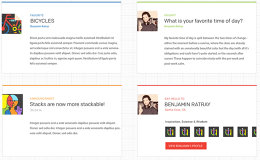The successes of WordPress, Shopify, and Magento have proven the usefulness of off-the-shelf code bases and tools--but their easy-to-use structure makes them difficult to customize for purposes they weren't built for. Custom-built code bases, on the other hand, are flexible but require professional construction. Both are viable solutions for different projects, but in an Internet future where design is king, getting 100% of your envisioned functionality is what distinguishes you in a saturated digital marketplace.
Take it from engineering firm Happy Fun Corp--they're the emergency responders who build the custom code base you should've bought in the first place.
The problem isn't that off-the-shelf doesn't work, says HFC Cofounder Ben Schippers. It's that you'll never get what you really want out of it. The off-the-shelf will get you 70% of the way toward the software, tool, or website solution you really wanted.
"At that point you've got to start assessing, 'Do I go really deep into this existing platform that I bought and hack around what I have to make it an 85% solution? Or do I scrap what I have now and built it from the ground up'--because you'll never get to 100%. You have to build something custom to get to 100%," says Schippers.
That 100% doesn't just mean functionality--Schippers is talking design. A decade ago, a website would be prized for its functionality, but it takes an attractive user interface to hook users for the bare second they spare to eye your website or app.
HFC deals with a lot of 911 emergency clients who either found their off-the-shelf codebase problematic or paid for an unsatisfactory custom codebase. A botched custom job could come from a freelancer in over their head or a foreign developer shop that's deaf to Western cultural needs. In all of these cases, HFC's client was looking to save money and ended up paying more down the line instead of contracting a good dev shop in the first place.
In the four years HFC has spent addressing clients with off-the-shelf code base emergencies, they've scrapped the off-the-shelf code base and built their clients a new one 70% of the time. HFC improves and builds out the client's existing off-the-shelf solutions for the other 30%--but reluctantly, and only because it's a money or time issue.
Off-The-Shelf? Sure, But Only As It Was Intended
Whereas HFC caters to midsize and established clients, Startup Giraffe is a four-man team that brainstorms solutions for small startups. They choose clients early in the development stage that haven't built full code bases yet--so-called "green field" projects. Most of the time, Startup Giraffe builds a young company's first custom code base instead of customizing off-the-shelf software, and the resulting custom solution ends up being much closer to the client's original vision. If any company needs to distinguish its product ASAP, it's a startup.
They'll still work with a company that's chosen to build their code base from an off-the-shelf solution. For a lot of very young companies, it's a good first step, says Startup Giraffe cofounder Amit Klein.
"For testing the market, validating your ideas, getting your first set of customers, it's very possible to use an existing [off-the-shelf] solution," says Klein. "Frameworks are really good for getting up and running really quickly. For a lot of people, it's a very good first step, using Drupal, Magento, Shopify. The problem with frameworks comes when you start making customizations and a lot of times, something that seems very straightforward can be very complex because you're doing something with the framework in a way that it doesn't want you to do it."
For long-term, Klein says, unless you're doing something very straightforward like simple e-commerce or blogging tools, it's generally better to do a custom job. The advantage of doing something custom is that you can control the experience from end to end. That comes with additional cost, but it allows you to be more nimble and to make more customizations. It's all about managing expectations.
Part Of Building Is Teaching
Often, first-time entrepreneurs have no idea why some code base-building services cost less. This is what can result in the aforementioned botched jobs, but Startup Giraffe doesn't do many 911 emergency code base rescues. The danger of using freelance work is the minefield that a code base can become when the delivered product does not match the client's expectations.
"Sometimes people come to us and say, 'Hey, we had this built in India for a few thousand bucks and it's 90% of the way there' and the answer is always no. Because it's a disaster," says Klein. "We don't like working on other people's code bases. We strongly prefer green-field projects and doing things right from day one."
It's gotten better, HFC's Schippers says. Circa 2011, half of HFC's customers would just walk up with an idea to bend WordPress or Magento to their vision. It would take at least two meetings for the client to understand the difference between what they're trying to build and what these services provide out of the box.
Building New Territory
And there are occasions where you're making something so new that, well, there IS no off-the-shelf solution. Josh Abrahmson created content portal CollegeHumor with high school friends way back in 1999--before there was really any website-building product, so they coded the site themselves. Then they coded their own e-commerce tools when they built apparel site BustedTees in 2004. That same year, Abrahmson was part of the team that brought Vimeo to life, the first video website that allowed users to upload content (YouTube wouldn't hit the Internet until 2005).
Abrahmson's teams had few, if any, options in the early years of website development. That's changed. Last year, Abrahmson's 10-person team had its hands full running BustedTees when they started spitballing a new apparel site. BustedTees is a profitable site, but it's a decade old. The future TeePublic would allow users to upload designs themselves for others to buy--a modern concept for modern consumers.
Unlike a larger company, BustedTees couldn't afford to hire on more developers to build a site for a project that might not fly. They contracted HappyFunCorp to build them a site. Once it went live, Abrahmson felt confident enough to hire on two more developers to maintain and grow TeePublic.
Where Off-The-Shelf Has Yet To Venture
While Startup Giraffe's small size keeps them agile, it also allows them to be picky with clients. More importantly, they've found a niche creating mobile code bases, a frontier with little (if any) off-the-shelf code base solutions.
Being a four-person company means Startup Giraffe has to distinguish itself from all the other dev shops--not just in choosing young clientele, but in developing its niche. After working on several iOS projects, Startup Giraffe veered away from Apple's constricting walled garden and into the undersaturated Android solutions market.
Most of Startup Giraffe's current projects are for Android, a less-crowded OS expertise niche with the added bonus of being the OS of choice for an ever-increasing range of devices from tablets to Arduinos. It's also has a great third-party ecosystem of tools and an open developer community that's always building more.
There are off-the-shelf options for mobile, but most of them are CMSs--appmakers to make simple apps for your restaurant or store, says Klein. The trick is that only a fraction of their custom programming actually ends up in the app--by volume, most of their code base goes into the communication between app and server. Klein is genuinely intrigued by mobile projects, but in this corner of programming's Wild West, Startup Giraffe has carved expertise in a field where off-the-shelf is lagging far behind.
The Shrinking Chance of In-House Development
The third option--building your code base in-house--is much harder these days thanks to the glut of startups sucking up all the good programming talent. Logically, this drives business into HFC's and Startup Giraffe's hands, but even they see the rising scarcity of skilled programmers in the developer landscape.
"It's always difficult to recruit top talent, and that's especially true these days. It's true for technologists and especially true for great mobile technologists. It's much easier to find a great WordPress developer than a great Android developer," says Klein.
The harder it is to find top talent--really, the more expensive it is to prolong timelines while you search for top talent--the more likely companies will choose to consult dev shops for solutions. This means a rising tide of professionalism, for better and for worse.
On the plus side, contracting a dev shop for a custom code base means getting a firm deadline, says BustedTees' Abrahmson. While BustedTees' in-house projects often took roughly 50% longer than expected to deploy, dev shops put their reputation on the line when contracted. Despite many off-the-shelf products promising customer support to help customize the code to your needs, it's still on your developer to build out your product--and that takes your own time.
But the saturation of tech and ascendence of good design means client expectations are higher, Klein says. It's not just MVPs that expect higher polished products and more functionality--the entire market expects it. That means it's getting more expensive to launch new products. Part of that is because dev shop clients themselves face new issues from the saturation: Customer acquisition is more expensive and people have higher expectations for the products they want to use.




















